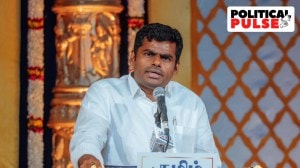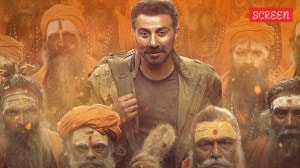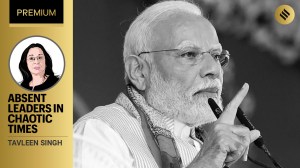UPSC Key: Pamban Bridge, Custodial Torture and Household Debt
Why India’s cotton economy is relevant to the UPSC exam? What is the significance of topics such as North American Free Trade Agreement, hands-off demonstration and pink bollworm (PBW), on both the preliminary and main exams? You can learn more by reading the Indian Express UPSC Key for April 7, 2025.
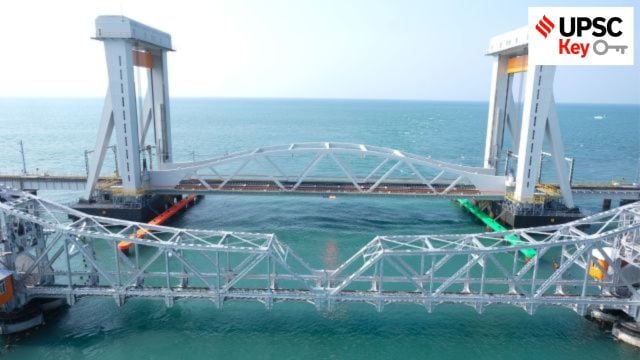 UPSC Key April 2025: Here's what you should be reading from the April 7, 2025 edition of The Indian Express
UPSC Key April 2025: Here's what you should be reading from the April 7, 2025 edition of The Indian Express
Important topics and their relevance in UPSC CSE exam for April 7, 2025. If you missed the April 6, 2025 UPSC CSE exam key from the Indian Express, read it here
THE WORLD
‘Hands Off!’ America sees biggest day of protests against Trump and Musk
Syllabus:
Preliminary Examination: Current events of national and international importance.
Main Examination: General Studies II: Effect of policies and politics of developed and developing countries on India’s interests, Indian diaspora.
What’s the ongoing story: Opponents of President Donald Trump and billionaire Elon Musk plan to rally across the US on Saturday to protest the administration’s actions on government downsizing, the economy, human rights and other issues.
Key Points to Ponder:
• What is a hands-off demonstration?
• What are Hands Off protestors’ demands
• What has led to widespread public dissent protests across US?
• Why protestors are targeting figures like Donald Trump and Elon Musk?
• Discuss the role of civil society and public protests in democratic governance, with reference to the recent ‘Hands Off!’ demonstrations in the United States.
Key Takeaways:
• More than 1,200 “Hands Off!” demonstrations have been planned by more than 150 groups, including civil rights organizations, labor unions, LBGTQ+ advocates, veterans and fair-elections activists. The protests are planned for the National Mall in Washington, DC, state capitols and other locations in all 50 states.
• Protesters are assailing the Trump administration’s moves to fire thousands of federal workers, close Social Security Administration field offices, effectively shutter entire agencies, deport immigrants, scale back protections for transgender people and cut federal funding for health programs.
• Musk, a Trump adviser who owns Tesla, SpaceX and the social media platform X, has played a key role in government downsizing as the head of the newly created Department of Government Efficiency. He says he is saving taxpayers billions of dollars.
• Activists have staged nationwide demonstrations against Trump or Musk multiple times since the new administration took power. But the opposition movement has yet to produce a mass mobilization like the Women’s March in 2017, which brought thousands of women to Washington, DC, after Trump’s first inauguration, or the Black Lives Matter demonstrations that erupted in multiple cities after George Floyd’s killing in 2020
• Organizers say they hope the recent demonstrations will be the largest since Trump returned to office in January.
Do You Know:
• The organizers of The Hands Off! protests have put forward three demands: end of billionaire takeover and corruption in the Trump administration, revoking the cutting of funds for Medicaid, Social Security and other programs on which people rely, and halt the attacks on trans people, immigrants and other communities.
Other Important Articles Covering the same topic:
📍Hands-off protesters rally against President Trump, Musk in cities across US
FRONT PAGE
PM inaugurates Pamban bridge, takes swipe at state govt with Tamil pitch
Syllabus:
Preliminary Examination: Economic and Social Development
Main Examination: General Studies II: Government policies and interventions for development in various sectors and issues arising out of their design and implementation.
What’s the ongoing story: Inaugurating India’s first vertical lift sea bridge — the Pamban rail bridge, linking Rameswaram island to the mainland — in Ramanathapuram district of Tamil Nadu, Prime Minister Narendra Modi on Sunday said it “symbolises the union of technology and tradition”.
Key Points to Ponder:
• What you know about Pamban Bridge?
• What are the features associated with the newly inaugurated Pamban Bridge?
• What is a vertical lift sea bridge?
• Map Work-Rameswaram island, Dhanushkodi and Ramanathapuram
• What is the difference between new and old Pamban Bridge?
• What happed to the British era Pamban Bridge?
• Why new Pamban Railway Bridge is significant?
• Know the historical and strategic importance of the Pamban region.
Key Takeaways:
• In a public address after the inauguration, Modi took a swipe at the DMK government in the state led by Chief Minister M K Stalin, who skipped the Pamban event.
• Amid the debate and opposition to the “three language formula” in Tamil Nadu, Modi played the “Tamil pride” card, emphasising the importance of the language and heritage, and even asking the state government to “start medical courses in Tamil language”.
• Saying that there is growing global interest in India today, he said: “People want to know India, want to understand India. India’s culture and our soft power also play a big role in this. The government is constantly trying to ensure that Tamil language and heritage reaches every corner of the world.”
• Modi’s remarks come in the backdrop of the state government opposing the National Eligibility-cum-Entrance Test (NEET) for admission to medical colleges.
• Earlier, Modi laid the foundation stone and dedicated to the nation various rail and road projects worth over Rs 8,300 crore. He also flagged off the Rameswaram-Tambaram (Chennai) Express and a Coast Guard ship which passed under the bridge.
• Modi also inaugurated some road infrastructure projects, including a 29-km-long four-laning of Viluppuram-Puducherry national highway; a 56.8-km-long four-laning of Poondiyankuppam-Sattanathapuram national highway; and a 48-km-long four-laning of Cholapuram-Thanjavur highway.
Do You Know:
• The new Pamban bridge will replace the British-era bridge of 1914 whose operation was stopped in December 2022. Built parallel to the old bridge at a cost of over Rs 700 crore, the new bridge is 2.08 km in length and features a 72.5-metre vertical lift span that rises up to a height of 17 metres, allowing smooth movement of ships while ensuring seamless train operations.
• The new bridge will replace the century-old original Pamban Bridge and is considered an engineering marvel with the tag of becoming India’s First Vertical Lift Railway Sea Bridge. Built with stainless steel reinforcements and Polysiloxane Paint, the bridge is designed to withstand harsh marine conditions. Its expected lifespan is up to 58 years. It has an automated electro-mechanical lift system, which will help the bridge rise to 17 meters, allowing smooth ship passage.
• With its genesis in the Indo-Ceylon (now Sri Lanka) trade during the British Era, the old bridge stood firm even during the horrific 1964 tsunami when a train full of passengers was washed away. According to railway officials, the new bridge is a testament to the railways’ engineering prowess and has elevated the benchmark of India’s infrastructure.
• On the night of December 23, 1964, a fierce tidal wave or tsunami hit Pamban Island very badly. The six coaches of the 653 Pamban-Dhanushkodi Passenger train crossed the bridge at around 11 pm and were en route to Dhanushkodi from Rameswaram.
• Dhanushkodi was the railhead for Indo-Ceylon traffic from where steamer service run by the Southern Railway to Talaimannar in Ceylon was available. It is the extreme point on Rameswaram Island. The island is approached from Mandapam, crossing the sea by the Pamban Bridge, beyond which Pamban Junction is situated. The line here branches off into two directions- one going to Rameswaram to the North-east and the other towards Dhanushkodi to the East. To its south is the Gulf of Mannar.
However, the train could not reach the destination, and it was completely washed away to sea, so much so that only the engine of the train was visible in the morning
• Before he became famous for the Delhi Metro, India’s legendary engineer, also called Metro Man of India, the restoration of the Pamban Bridge was one of the earliest major works of E. Sreedharan.
Other Important Articles Covering the same topic:
📍The new Pamban Bridge and story of the 1964 cyclone, when a train full of passengers was washed away
THE EDITORIAL PAGE
Syllabus:
Preliminary Examination: Economic and Social Development-Sustainable Development, Poverty, Inclusion, Demographics, Social Sector Initiatives, etc.
Main Examination: General Studies II: Important aspects of governance, transparency and accountability
What’s the ongoing story: Prakash Singh Writes: India must enact a law against torture, ratify the UN Convention, and take effective steps to insulate the police from external pressures as mandated by the Supreme Court
Key Points to Ponder:
• What is Custodial Torture?
• What are the ethical concerns regarding Custodial Torture?
• What exactly the report ‘comprehensive report on police torture and (un)accountability’ says?
• What is UN Convention (1984)?
• What is the role of the judiciary in curbing custodial violence in India?
• India has signed but not ratified the UN Convention Against Torture—Why?
• Discuss the significance of police reforms in India in light of recurring incidents of custodial torture and deaths.
• What measures can ensure greater transparency and accountability in policing?
Key Takeaways:
Prakash Singh Writes:
• Common Cause, a reputed NGO, in collaboration with the Lokniti Programme of the Centre for the Study of Developing Societies (CSDS), released a comprehensive report on police torture and (un)accountability on March 26.
• It explores the nature, causes and factors that contribute to the perpetuation of police violence and torture in India. The study is based on interactions with 8,276 police personnel of different ranks across 17 states and union territories. The findings of the study bring out some very disturbing features. There are, however, some redeeming features as well.
• An encouraging part of the report is where the researchers found that an overwhelming 79 per cent of police personnel favour training in human rights, 71 per cent recommended prevention of torture and 79 per cent supported evidence-based interrogation techniques.
• The report says that there was consensus among lawyers and judges that confessions to the police should never be made inadmissible. It is worthwhile placing on the record that the Malimath Committee had suggested that confessions made before a senior police officer of the rank of Superintendent or above should be admissible in evidence with safeguards to prevent coercion. The Law Commission of India had also, in its 69th Report (1977), proposed introducing Section 26A in the Indian Evidence Act to make confessions before senior police officers admissible.
• A serious lacuna in the report is that it has not made any observations on the factors that contribute to the use of torture in the Indian context. Very briefly, these are: A continuation of the colonial police culture, for which there is no justification, the near absence of accountability, pressure from the political masters and even senior officers for quick results, inadequate training, and public support for short-cut solutions because of the failure of the criminal justice system to deliver within a time-frame.
• Torture is, sadly, practised by police forces across the world. The most sophisticated and brutal techniques are used by the police in the US. Guantanamo Bay gained worldwide notoriety for its inhuman treatment of detenus. Iraq’s Abu Ghraib prison highlighted the brutal methods used in the interrogation of terror suspects. About Russia, China and Pakistan, the less said, the better.
• This is, however, not to justify the use of torture under any circumstances. India must enact a law against torture, ratify the UN Convention, and take effective steps to insulate the police from external pressures as mandated by the Supreme Court. Such measures will lead to police becoming humane and professional, upholding the rule of law, respecting human rights and winning over the trust and confidence of the people.
Do You Know:
Prakash Singh Writes:
• Torture has been defined in the UN Convention (1984) as “any act by which severe pain or suffering, whether physical or mental, is intentionally inflicted on a person for such purposes as obtaining from him or a third person information or a confession, punishing him for an act he or a third person has committed or is suspected of having committed, or intimidating or coercing him or a third person, or for any reason based on discrimination of any kind when such pain or suffering is inflicted by or at the instigation of or with the consent or acquiescence of a public official or other person acting in an official capacity.”
• India signed the UN Convention against Torture (UNCAT) in 1997 but has not ratified it, which means it is legally not binding on India.
• The report brings out that 20 per cent of the police personnel feel that it is “very important” for the police to use “tough methods” to create fear amongst the public and another 35 per cent think it is “somewhat important.”
• In other words, 55 per cent of police personnel favour tough methods to some degree. Significantly, they have not talked of torture. What these tough methods are and at what stage they assume the dimensions of torture have not been clarified in the report.
• In cases involving sexual harassment and child lifting, one in four police personnel justify mob violence, implying that they do not mind mobs acting as the judge, jury and executioner in such cases.
• Another disturbing finding is that 22 per cent of police personnel believe that killing “dangerous criminals” is better than giving them a legal trial. But, it is also a fact that 74 per cent police personnel are of the view that “no matter how dangerous a criminal is, the police should try to catch them and try to follow proper legal procedures.”
• In matters of arrest, although 41 per cent police personnel said that the procedures are “always” adhered to, 24 per cent said that they are “rarely or never” adhered to. Kerala, where 94 per cent said “always”, reported the highest compliance.
• On the use of third-degree methods, 30 per cent of police personnel said that these are justified towards the accused in serious criminal cases. Surprisingly, 9 per cent justified these methods even in petty offences. The victims of torture are, unfortunately, mostly from poor and marginalised communities. The groups generally targeted are Adivasis, Dalits and Muslims, people who cannot read and write, and slum dwellers.
• Custodial deaths showed discrepancies in figures furnished by different agencies. Thus, in the year 2020, the National Crime Records Bureau (NCRB) reported 76 cases, while the National Human Rights Commission reported 70 cases. The National Campaign Against Torture (NCAT), a civil society initiative, documented 111 cases. It was a shocking revelation that during 2018-22 there were zero convictions for deaths in police custody.
Other Important Articles Covering the same topic:
UPSC Previous Year Prelims Question Covering similar theme:
1. With reference to India, consider the following statements: (2020)
1. Judicial custody means an accused is in the custody of the magistrate concerned and such an accused is locked up in a police station, not in jail.
2. During judicial custody, the police officer in charge of the case is not allowed to interrogate the suspect without the approval of the court.
Which of the statements given above is/are correct?
(a) 1 only
(b) 2 only
(c) Both 1 and 2
(d) Neither 1 nor 2
UPSC Previous Year Mains Question Covering similar theme:
📍National Human Rights Commission (NHRC) in India can be most effective when its tasks are adequately supported by other mechanisms that ensure the accountability of a government. In light of above observation assess the role of NHRC as an effective complement to the judiciary and other institutions in promoting and protecting human rights standards. (2014)
THE IDEAS PAGE
Syllabus:
Preliminary Examination: Current events of national and international importance.
Main Examination: General Studies II: Effect of policies and politics of developed and developing countries on India’s interests.
What’s the ongoing story: Nirvikar Singh Writes: It is likely that the tariffs are mainly aggressive starting points for a negotiation process that will proceed bilaterally. But the Trump approach undermines institutions and trust
Key Points to Ponder:
• What can be the potential impact of recent US tariff policies on India’s trade sector?
• Recent US tariff policies on India’s trade sector—What you know about the same?
• What factors contribute to India being relatively less affected than countries like China?
• How India can recalibrate its trade strategy to safeguard its export interests while enhancing global competitiveness?
• Evaluate the implications of the US-China trade war on India’s economy.
• Do you think that India can leverage this opportunity to enhance its export share?
• “Trade wars have no winners.”—Discuss
Key Takeaways:
Nirvikar Singh Writes:
• US President Donald Trump clearly believes in the slogan “Make America Great Again”. The problems with this vision include the flaws in his idea of “greatness”, other (less noble) goals for which the slogan is a cover, and the inhumane and chaotic implementation of his programme.
• Compared to attacks on democracy and human rights, the new tariff policies announced on April 2 may seem relatively benign.
• The challenges of global rules for trade in an unequal world were reflected in the fact that, while the International Monetary Fund and the World Bank began operating soon after the end of the war, the World Trade Organisation (WTO), the third pillar of the post-war global order, had to wait for five decades.
• As other countries recovered from the war’s devastation or achieved developed country status for the first time, the US has been regularly frustrated with unequal market access. This is at the heart of Trump’s claims of unfairness — the US no longer dominates the global economy as in 1945 but is expected to live with a system that gives the rest of the world an advantage in market access.
• As the global economy has grown, other countries have developed capabilities in manufacturing and areas of comparative advantage that they previously lacked. In 1950, Japan barely had an automobile industry, but by the 1980s it was a global leader, only to be forced by the US to implement “voluntary” export restraints.
• Unfortunately, Trump-style tariffs are not going to solve this problem of structural change, driven by growth, technology and trade. The baseline US tariff rate of 10 per cent, announced on April 2, could potentially raise USD 200 billion, but this will mostly be paid by US households, as a regressive consumption tax.
• The impact on US manufacturing and jobs will be very small. The Trump tariffs are much higher for countries that have been singled out as having high trade barriers.
Do You Know:
Nirvikar Singh Writes:
• The Trump tariffs increase transaction costs, and they increase uncertainty. Both will damage the global economy, something already reflected in the steep falls in stock markets.
• International trade will be reduced, and some will simply be diverted, with a messy scramble to adjust throughout various supply chains or production networks. The Trump approach undermines institutions, and it undermines trust.
• The US may gain some market access and ultimately lower some tariffs or trade barriers on its exports but in the least efficient manner possible. Meanwhile, retaliatory tariffs and trade disruptions will reduce economic growth around the globe, and that will have negative consequences for India.
• Nevertheless, having been slow to open up its economy, the impact for India will be lower than for some other countries. One prediction has China’s short-term growth being cut in half by the Trump tariffs. Dealing with the Trump tariffs adds an important wrinkle, but only a wrinkle, to a possible trade strategy for India — one which continues to focus on bilateral trade deals, on promoting foreign investment and access to foreign know-how from multiple sources, and on integrating into global production networks.
Other Important Articles Covering the same topic:
📍ExplainSpeaking: Trump’s reciprocal tariffs — impact on India, rest of the world
Syllabus:
Preliminary Examination: Economic and Social Development
Main Examination: General Studies III: Indian Economy and issues relating to planning, mobilization, of resources, growth, development and employment.
What’s the ongoing story: Ishan Bakshi Writes: Not only are more households taking on debt, they are also taking on more debt than before. This speaks of structural defects in the economy
Key Points to Ponder:
• What is the household debt?
• How household debt is calculated?
• What is the household debt of India?
• Rural households in India are more indebted than urban households, especially in terms of credit from formal sources—True or False?
• What is “debt servicing ratio”?
• ‘Rising household debt in India is a reflection of deeper structural problems in the economy’—Why?
• What are the socio-economic implications of rising indebtedness among rural and urban households?
• Discuss the impact of household debt trends on India’s consumption-led growth model.
Key Takeaways:
Ishan Bakshi Writes:
• In the previous decade, it was the twin balance sheet problem — of an over-leveraged corporate sector and a banking system plagued by bad loans — that was holding back private investments. The question now is whether high household debt is holding back private consumption.
• Household debt has surged dramatically in the years after the pandemic — rising from 36.6 per cent of GDP in June 2021 to 40.2 per cent by December 2023 and further to 42.9 per cent as of June 2024.
• To put this in perspective — it had averaged around 33 per cent between 2015-19. This credit surge, post Covid, has not just been concentrated in a particular segment of the population, but has been more widespread in nature. The increase can be seen in the flow of credit to households across the entire income distribution.
• Between March 26, 2021 and March 22, 2024, personal loans by the banking sector grew by 75 per cent. Over the same period, retail credit extended by non-banking finance companies and housing finance companies grew by 70 per cent, while loans from microfinance institutions rose by 67 per cent. In comparison, during this period, household disposable income grew by 43 per cent and consumption by 49 per cent.
• Had it not been for this surge in debt, and if household borrowings over these years had been in line with past trends, then private consumption would have been lower by around 2 percentage points of GDP or savings would have fallen.
Do You Know:
Ishan Bakshi Writes:
• Household debt is defined as all liabilities of households (including non-profit institutions serving households) that require payments of interest or principal by households to the creditors at a fixed dates in the future. Debt is calculated as the sum of the following liability categories: loans (primarily mortgage loans and consumer credit) and other accounts payable. The indicator is measured as a percentage of net household disposable income.
• Greater indebtedness implies that loan repayment will account for a bigger portion of household disposable income. And unless incomes grow rapidly, the burden of repayment will eat into disposable incomes, impacting spending capacity.
• It is not as if this credit binge went unnoticed. In November 2023, the RBI introduced various measures — increasing the risk weights on banks’ exposure to NBFCs and on consumer credit for some segments — to slow down credit growth. However, with growth slowing down sharply — the hit to consumption reflects in the commentary from India Inc — the central bank has now reversed its stance partially.
• Loans that are overdue for more than 90 days are estimated to be inching upwards. Delinquencies are increasing in gold loans, and asset concerns are arising in the personal and consumer finance segment, and also in the passenger vehicle and two-wheeler segments. In the case of MFIs, loans that are due for 31-180 days have risen considerably in recent months. Banks have also been steadily writing off unsecured retail loans, indicating a worsening of asset quality.
Other Important Articles Covering the same topic:
UPSC Previous Year Prelims Question Covering similar theme:
2. As per the NSSO 70th Round “Situation Assessment Survey of Agricultural Households”, consider the following statements: (2018)
1. Rajasthan has the highest percentage share of agricultural households among its rural households.
2. Out of the total agricultural households in the country, a little over 60 percent belong to OBCs.
3. In Kerala, a little over 60 percent of agricultural households reported to have received maximum income from sources other than agricultural activities.
Which of the statements given above is/are correct?
(a) 2 and 3 only
(b) 2 only
(c) 1 and 3 only
(d) 1, 2 and 3
ECONOMY
Trade ministry begins expanding NAFTA wing as India seeks quick US tariff truce
Syllabus:
Preliminary Examination: Current events of national and international importance.
Main Examination: General Studies III: Bilateral, regional and global groupings and agreements involving India and/or affecting India’s interests.
What’s the ongoing story: In a bid to strike an early trade deal with the US and potentially sidestep the 26 per cent reciprocal tariffs, the Ministry of Commerce and Industry has stepped up efforts by expanding its NAFTA division, which handles India’s bilateral trade with the United States, Canada, and Mexico.
Key Points to Ponder:
• What is the North American Free Trade Agreement (NAFTA)?
• ‘India’s efforts to expand its NAFTA wing reflect its intent to recalibrate trade relations with North America, especially the United States’—Discuss
• What are the implications of tariff disputes and negotiations on India’s trade policy?
• How US tariff measures can impact on Indian exports ?
• Know the role of bilateral trade talks in addressing tariff-related concerns in the absence of a Free Trade Agreement (FTA).
Key Takeaways:
• The ministry has begun assigning new officers to strengthen the NAFTA (North American Free Trade Agreement) division as more coordination officers would help the division manage the workload better. Senior officers nearing the end of their term in the ministry may also see their tenures extended, two government officials aware of the development said.
• A swift deal with the US is crucial for Indian exports, as several countries hit with high reciprocal tariffs—such as Vietnam and Cambodia—have signalled to the US their willingness to slash tariffs on American goods under a trade agreement. The US is also in talks with several other countries that have expressed interest in such deals.
• “Just had a very productive call with To Lam, General Secretary of the Communist Party of Vietnam, who told me that Vietnam wants to cut their tariffs down to ZERO if they are able to make an agreement with the US. I thanked him on behalf of our country, and said I look forward to a meeting in the near future,” US President Donald Trump said in a social media post.
• Vietnam, facing 46 per cent US reciprocal tariffs, has also requested a delay of at least 45 days in the imposition of these duties to allow time for negotiations that could prevent a move detrimental to both the Vietnamese economy and American consumers. Vietnam’s tariffs on US goods stand at 9.4 per cent—lower than India’s tariffs on US imports.
• Meanwhile, Cambodian Prime Minister Hun Manet has sought negotiations after the US government imposed a 49 per cent tariff on products from Cambodia. According to Chinese news agency Xinhua, Manet stated that Cambodia is committed to promoting US-based product imports, with an immediate reduction of tariffs on 19 product categories from a maximum bound rate of 35 per cent to a 5 per cent applied tariff rate.
• However, India is yet to sign a full-fledged trade deal with any Western country due to significant differences over labour and environmental standards. India’s trade agreements with the European Union and the UK have been under negotiation for several years.
Do You Know:
• According to the Investopedia, the North American Free Trade Agreement (NAFTA) was implemented to promote trade among the United States, Canada, and Mexico. The agreement, which eliminated most tariffs on trade among the three countries, went into effect on Jan. 1, 1994. Numerous tariffs, particularly those related to agricultural products, textiles, and automobiles, were gradually phased out through Jan. 1, 2008.
• NAFTA was terminated and replaced by the United States-Mexico-Canada Agreement (USMCA) in 2020.
• Indicating that the US would likely press India on a range of issues during trade talks, a report by the United States Trade
Representative (USTR) expressed concerns about data localisation requirements for payment service providers and banks. The USTR report also stated that the US has placed India on the ‘Priority Watch List’ due to inconsistent progress on intellectual property (IP) issues. It cited the absence of specific laws for “trade secret protection” and long waiting periods for patent approvals as major concerns.
• Additionally, the US has raised concerns over India’s price caps on coronary stents and knee implants, arguing that these controls have not kept pace with inflation and do not consider production costs or innovation, potentially discouraging US companies from operating in the Indian market.
Other Important Articles Covering the same topic:
📍India-US trade deal: First tranche by Fall, but no relief yet on reciprocal tariffs
EXPRESS NETWORK
Delhi spends most time on work-related activities, Nagaland least, finds govt survey
Syllabus:
Preliminary Examination: Economic and Social Development-Sustainable Development, Poverty, Inclusion, Demographics, Social Sector Initiatives, etc.
Main Examination:
• General Studies I: Social empowerment
• General Studies III: Inclusive growth and issues arising from it
What’s the ongoing story: People in Delhi spend an average of 563 minutes each day in work-related activities while those in Nagaland spend the lowest, 329 minutes, according to data from a national survey conducted by the Ministry of Statistics and Programme Implementation.
Key Points to Ponder:
• What is the Time Use Survey?
• What are the key findings of TUS 2024?
• Time Use Survey 2024-what are key highlights?
• How can this survey help in policy-making?
• What are the areas of concern?
• What does the survey tell about the contribution of women in domestic work?
Key Takeaways:
• The Time Use Survey (TUS) 2024 reveals that Delhi’s residents are more time-intensive in their daily routines. With 563 minutes spent on “employment and related activities”, they significantly surpassed the national average of 440 minutes, even showing an increase from 510 minutes recorded in the last such survey in 2019.
• Goa follows closely, with its residents clocking 536 minutes on work-related tasks, a rise from the 367 minutes recorded in the 2019 survey.
• The Time Use Survey tracks how people allocate their time across various activities such as paid work, childcare, volunteering, and socialising. The primary aim of the survey is to assess men’s and women’s participation in both paid and unpaid activities, providing insights into time spent on unpaid caregiving, volunteer work, and domestic services. It also sheds light on time spent on learning, socialising, leisure activities, and self-care.
• The findings of this survey are crucial for shaping policies on poverty, gender equity, and human development.
Do You Know:
• Over the past three decades, many developed countries have increasingly conducted time-use surveys. For instance, the US has been conducting annual surveys since 2003, while Australia began its full-scale national survey in 1992, and Canada has been conducting them since 1961. Countries like Germany, Austria, and Israel have also embraced similar surveys.
• India’s first national Time Use Survey, the NSS Report – Time Use in India, was released in 2019. The second round of the survey, findings of which were released this year, was conducted between January and December 2024, covering 1.39 lakh households and 4.54 lakh individuals over the age of six.
• The latest survey reveals that Indians engaged in employment and related activities spend an average of 440 minutes per day on such tasks. Men spend an average of 473 minutes in work-related activities while women spend 341 minutes.
• The survey also reveals that the average time spent in India on learning activities has declined to 414 minutes in 2024 from 424 minutes in 2019. The states with the highest time spent on learning activities are Andhra Pradesh, where people spend an average of 465 minutes per day, up from 451 minutes in 2019. Tamil Nadu residents spend 462 minutes, slightly down from 469 minutes in the previous survey, but still among the highest in the nation. Delhi stands out with a significant increase in learning time, jumping from 403 minutes in 2019 to 456 minutes per day in 2024.
• Nagaland reported the lowest average, with 368 minutes spent on learning activities, down from 419 minutes in 2019, suggesting a need for greater emphasis on education in the state.
• The 2024 survey also shows how social interactions and community participation are evolving across India.
Other Important Articles Covering the same topic:
📍Females spent 201 mins more than males in unpaid household work: Time Use Survey 2024
📍Knowledge Nugget: What is the relevance of ‘Time Use Survey’ for UPSC?
UPSC Previous Year Mains Question Covering similar theme:
📍Distinguish between ‘care economy’ and ‘monetized economy’. How can the care economy be brought into a monetized economy through women empowerment? (2023)
EXPLAINED
Why UGC will issue equivalence certificates for foreign degrees
Syllabus:
Preliminary Examination: Economic and Social Development
Main Examination: General Studies II: Issues relating to development and management of Social Sector/Services relating to Health, Education, Human Resources.
What’s the ongoing story: The University Grants Commission (Recognition and Grant of Equivalence to Qualifications Obtained from Foreign Educational Institutions) Regulations 2025 were notified on Friday.
Key Points to Ponder:
• What do these regulations apply to?
• What are the conditions for granting equivalence?
• What is the process for granting equivalence certificates?
• How has equivalence been determined thus far?
• Why have the regulations been issued?
Key Takeaways:
• These regulations specify the procedure for obtaining equivalence certificates, which are documents certifying that a qualification obtained in an educational institution abroad (like a degree or diploma) is equivalent to a comparable qualification in India.
The UGC made a draft of these regulations public in 2023. The regulations have now been notified after considering the feedback.
• A qualification — a certificate, diploma, or degree — from a foreign institution can be recognised for grant of an equivalence certificate if:
—It was awarded by a foreign institution that is recognised under the laws in its home country;
—The entry-level requirements (like minimum credit requirements, or requirements of a thesis or internship) for admission to the programme are similar to a programme of that sort offered in India; and
—If the student has pursued the programme as per the norms and standards specified by the foreign institution.
• Qualifications obtained from off-shore campuses of foreign institutions can also be granted an equivalence certificate, provided that the academic programme complies with requirements in the country where the campus is located and in the country of origin of the institution.
• The regulations will apply to school qualifications obtained by a student from abroad, in case they want to apply for admission to an undergraduate programme in India. For this, the student needs to have completed at least 12 years of school education.
Do You Know:
• With some exceptions, the equivalence certificates will be valid for all academic institutions under the UGC, for higher education and research, and for employment in cases where a qualification recognised by the UGC is essential.
• Disciplines like medicine, pharmacy, nursing, law, and architecture, and “other qualifications regulated by the norms of respective Statutory Councils in India” will not be covered under the regulations.
• They will, however, be applicable for qualifications obtained via distance or online learning modes, contrary to what the draft regulations said. This change was made due to feedback received, UGC chairman M Jagadesh Kumar told The Indian Express.
Equivalence certificates will not be required for qualifications obtained from foreign institutions that have collaborations with Indian institutions under UGC regulations for twinning/joint/dual degree programmes, or for setting up foreign institutions in India.
Other Important Articles Covering the same topic:
📍Explained | UGC’s guidelines on foreign academic qualifications
Syllabus:
Preliminary Examination: Economic and Social Development
Main Examination: General Studies III: Major crops-cropping patterns in various parts of the country, issues and related constraints;
What’s the ongoing story: India’s cotton economy isn’t in great shape. This, despite the advantage the country has as a producer of the natural fibre and its textile exports facing only 27% duty – as against China’s 54%, Vietnam’s 46%, Bangladesh’s 37%, Indonesia’s 32% and Sri Lanka’s 44% – under US President Donald Trump’s “reciprocal tariff” policy.
Key Points to Ponder:
• India’s cotton economy-What you know about the same?
• India is the largest producer of cotton in the world—True or false?
• What are the issues and challenges facing cotton farmers in India today?
• What is the impact of genetically modified (GM) crops like Bt cotton on cotton economy?
• How do climate change and erratic weather patterns affect rainfed crops such as cotton in India?
• Examine the linkage between farm-level cotton crisis and India’s competitiveness in the global textile market.
Key Takeaways:
• India’s cotton output in the 2024-25 marketing year (October-September) is projected at just over 294 lakh bales (lb; 1 lb=170 kg), the lowest since the 290 lb of 2008-09. Production has been on a declining path since the peak of 398 lb in 2013-14 (see chart 1). A fall from almost 400 lb to under 300 lb can even be termed catastrophic.
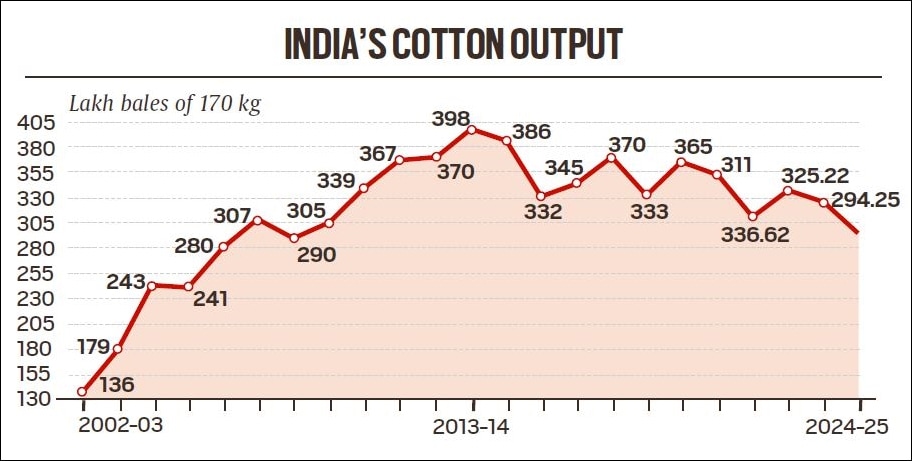 Source: Cotton Advisory Board/Cotton Association of India /Committee on Cotton Production & Consumption
Source: Cotton Advisory Board/Cotton Association of India /Committee on Cotton Production & Consumption
• The cultivation of genetically modified (GM) cotton hybrids – incorporating alien genes isolated from a soil bacterium, Bacillus thuringiensis or Bt – had led to not only a near-trebling of production (from 136 lb to 398 lb), but also a 139-fold jump in exports (from 0.8 lb to 117 lb), between 2002-03 and 2013-14.
• The above production slide, and India turning from a large cotton exporter to a net importer, is mainly courtesy of the pink bollworm (PBW). This is an insect pest, whose larvae bore into the bolls (fruits) of the cotton plant. The bolls contain seeds from which the white fluffy cotton fibres or lint grow. The PBW caterpillars feed on the developing seeds and the lint, causing yield loss as well as lint discolouration
Do You Know:
• The pink bollworm (PBW), known among farmers as gulabi sundhi, damages the cotton crop by burrowing its larvae into the cotton bolls. This results in the lint being cut and stained, making it unfit for use. While there exist effective techniques to prevent PBW attacks, these methods gave not seen widespread adoption by farmers.
• The GM cotton now grown in India have two Bt genes, ‘cry1Ac’ and ‘cry2Ab’, coding for proteins toxic to the American bollworm, spotted bollworm and cotton leafworm pests. The double-gene hybrids initially provided some protection against the PBW too, but that effectiveness has dissipated over time.
• The reason for it is that the PBW is a monophagous pest, which feeds exclusively on cotton. This is unlike the other three pests that are polyphagous and survive on multiple host crops: The American bollworm larvae infest even maize, jowar (sorghum), tomato, bhindi (okra), chana (chickpea) and lobia (cowpea).
• Being monophagous enabled the PBW larvae to gradually build resistance to the toxins from the existing Bt cotton hybrids. The PBW population that became resistant from continuously feeding on these plants eventually overtook and replaced the ones that were susceptible. The pest’s short life cycle (25-35 days from egg laying to adult moth stage), allowing it to complete at least 3-4 generations in a single crop season of 180-270 days, further accelerated the resistance breakdown process.
• A recent article in the Nature scientific journal showed the PBW developing resistance to both cry1Ac and cry2Ab toxins by 2014, about 12 years after Indian farmers began cultivating Bt cotton.
Other Important Articles Covering the same topic:
📍Scourge of the pink bollworm, and why cotton farmers struggle to deal with it
UPSC Previous Year Prelims Question Covering similar theme:
3. The black cotton soil of India has been formed due to the weathering of (2021)
(a) brown forest soil
(b) fissure volcanic rock
(c) granite and schist
(d) shale and limestone
4. A state in India has the following characteristics: (2011)
1. Its northern part is arid and semi-arid.
2. Its central part produces cotton.
3. Cultivation of cash crops is predominant over food crops.
Which one of the following states has all of the above characteristics?
(a) Andhra Pradesh
(b) Gujarat
(c) Karnataka
(d) Tamil Nadu
UPSC Previous Year Mains Question Covering similar theme:
📍Analyse the factors for highly decentralized cotton textile industry in India. (2013)
| PRELIMS ANSWER KEY |
| 1. (b) 2.(c) 3.(b) 4.(b) |
For any queries and feedback, contact priya.shukla@indianexpress.com
Subscribe to our UPSC newsletter. Stay updated with the latest UPSC articles by joining our Telegram channel – IndianExpress UPSC Hub, and follow us on Instagram and X.
Must Read
Buzzing Now


Apr 13: Latest News
- 01
- 02
- 03
- 04
- 05





